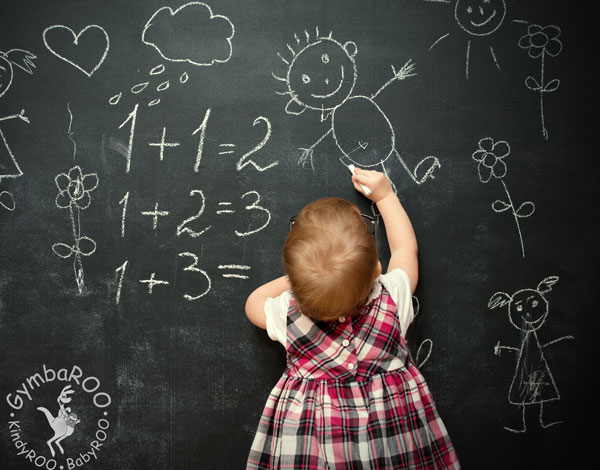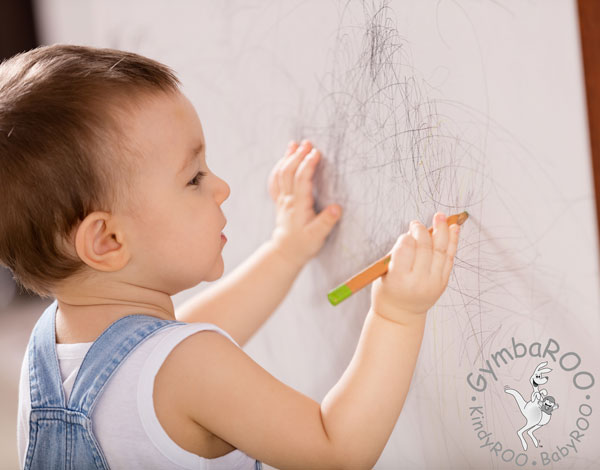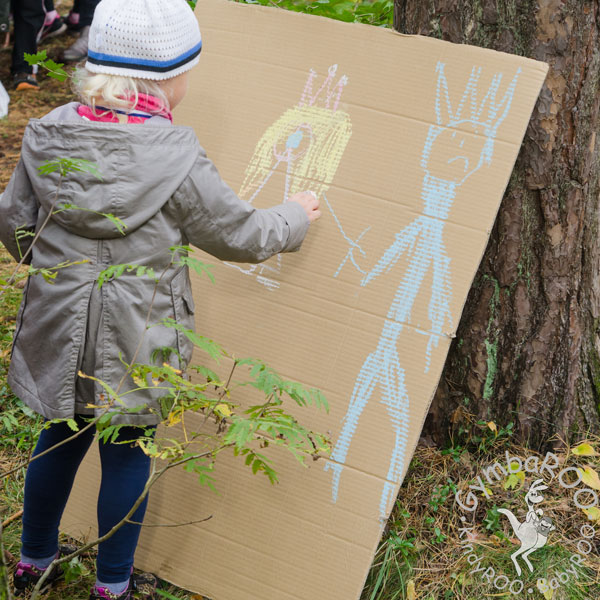Join the thousands of parents already raising smarter, happier babies with our online baby classes: The Active Babies Smart Kids series. Click here.
GymbaROO-KindyROO kids are excelling academically, emotionally, in leadership roles and on the sporting field. Find us at: GymbaROO-KindyROO
Did you know, that about the time your baby walks, he should be given a thick, soft, black crayon and a large piece of paper firmly fixed in front of him while he sits on the floor? You then draw some meaningless lines and dots, put the crayon in your baby’s hand and suggest he ‘draws’. If you repeat this every few days, your baby will soon learn to make his own ‘mark’ and will be on his way to mastery of the written word!
Around 18 months, your toddler should draw standing at an upright surface to develop control of back and arm muscles – necessary for the development of the fine muscles of the hands and fingers, and needed for control of a pencil for writing letters and numerals. Again, black is the most definite colour and a thick black crayon is best.
Scribbles are the order of the day – at first up and down or across, then by two years of age, circular. These scribbles become definite objects in your child’s eye (if not yours), during the following year. This is an important milestone for your child. As memory develops, a child can visualise or imagine what they are drawing – a skill is very important to learning and remembering the ‘look’ of letters and words later. As the child approaches four years of age, the drawings gradually become more recognisable to us.
Free drawing is important for young children, as it encourages imagination and visualisation. Do not encourage ‘copying’ or ‘colouring-in’, rather let their imagination/visualisation develop. Try to refrain from asking ‘What is that?’ They will tell you if they want to! Do not hurry your child through the scribbling stage – it is part of a child’s ‘mind’ development and is best left to the natural development of your child.
Painting with a thick brush on large paper attached to an easel, a firm large piece of cardboard or a blackboard is more definite than crayon and can be provided as an alternative from two years of age. Around this time, different colours start to be recognised as colour discrimination begins to emerge, so provide different coloured thick crayons, chalk and/or paint for your child.
Blackboards (chalkboards) and chalk are still considered to be one of the best drawing aids for children. They not only get the pleasure of seeing their ‘art’ on the wall, but they use both their big muscles and their small muscles to create their masterpieces! If you decide to purchase a blackboard, make sure it is upright and large enough for a child to make large, sweeping arm movements, (same applies to easels). Many are too small and restrict a child’s full-arm movement ability. To ensure your child has a big enough blackboard, we suggest you make your own – this is very easy to do!
How to make your own blackboard!
- Purchase a piece of Masonite 2 x 1 metres if you have room, smaller if necessary. It needs to be wide enough for your child to use when their arms are stretched fully to each side of their body.
- Before attaching this to a wall, paint the smooth side with two coats of white sealer paint, lightly sandpaper, then paint it with two coats of blackboard paint. Black or green is best, as dark colours provide better contrast for your child’s drawings.
- When the paint is completely dry, you’ll need to ‘chalk the board in’. To do this, hold a piece of white chalk on its side, completely rub it all over the board, then clean the board with a chalkboard duster. The blackboard will not work if it is not ‘chalked in’ first.
- Mount the board so that the middle of the board is at approximately level with your child’s chin. This will mean placing the blackboard at floor level for your toddler, if it is a big board. Note: Place the blackboard in an area where you and your child will most often be. If you put it in an out-of-the-way place you can guarantee it won’t be used! Children like to play close to where you are.
- Make a grooved ledge to go along the bottom to hold the chalk and to stop the chalk dust going onto the floor. If mounting the board over carpet, place a metre-wide plastic strip underneath to catch the dust.
- Provide your child with chunky chalk as it is easy to hold, manipulate and does not break easily. Buy a box of mixed colours. Purchase a couple of dusters.

A blackboard is irresistible, not only for children but frequently for visiting adults! It will also be useful once your children go to school. Blackboards are great for practicing full arm writing patterns, learning basic letter formations, writing and spelling. Every home should have one!
Blackboard activity ideas
- Large, free, sweeping arm movements, scribbling and just making marks and rubbing them off is fun for little ones. Let them experiment with the different colours.
- Draw a big circle and turn it into something e.g. a face, apple, ball.
- Draw two parallel lines and suggest your child runs a toy car along your road! As your child manages this, make your road with a few curves. How about a figure- eight race track?
- Draw a house on one side of the board and a tree on the other. Suggest your child draw a line from the tree to the house for a path.
- Trace over lines in different colours. Pre-schoolers will love simple patterns. Join the dots to form a picture.
- Using two hands, suggest your child simultaneously draw:
- Two lines going up and down.
- Two circles.
- Lines going from the centre out to both sides and back.
- For older preschoolers, draw a big clock and suggest your child draws a line from a centre dot to each of the numbers.
- Play chase the dot. You make a dot for your child to draw a line to, then another etc.
Original article by Margaret Sasse: Founder of GymbaROO. Adapted by Bindy Cummings. Bindy Cummings (B.Ed hons) is a teacher and a GymbaROO early childhood neuro-developmental consultant. She is the Editor of GymbaROO’s First Steps magazine, digital articles and media.
GymbaROO-KindyROO
Thousands of parents, babies and children are presently involved in our programs and creating rising stars. GymbaROO-KindyROO kids are excelling academically, emotionally, in leadership roles and on the sporting field. Come join all the fun and learning! “GymbaROO – The best decision I ever made for my child.” Classes from 6 weeks old – 7 years GymbaROO KindyROO
Active Babies Smart Kids – Online Baby Classes
GymbaROO-KindyROO’s online series of baby classes is taking the parenting world by storm! It is highly recommended by doctors, paediatricians, early childhood experts and the Maternal Child and Family Health Nurses Association. This series is being called: “The essential guide for parents”. Join the thousands of parents already playing with their babies from birth, in the best way for brain and body development and laying crucial foundations for future learning. What happens in the first year, not only matters, it matters a lot! Enjoy the introductory video below.
Click here: Active Babies Smart Kids online series of baby classes
Try the first episode FREE: Tummy time + baby fun and development class 1
Enjoy the following GymbaROO-KindyROO articles
GymbaROO-KindyROO: Who, what, where, why and how
All about GymbaROO-KindyROO’s online baby classes for parents and babies: Active Babies Smart Kids
How to raise a smarter, happier baby
Finger Painting – A brilliant activity for babies and toddlers.
Why GymbaROO kids excel at the three R’s – wRiting, Reading, aRithmetic (maths).
The skills needed for writing begin in infancy. What parents can do.
Handwriting makes kids smarter than using keyboards: Activities for 0 – 5 year olds.
Handedness – Developing a preferred hand, does it matter?
NAPLAN results improve with LESS reading and maths and MORE GymbaROO.
Why your elected childcare, preschool or school needs a GymbaROO sensorimotor program.



